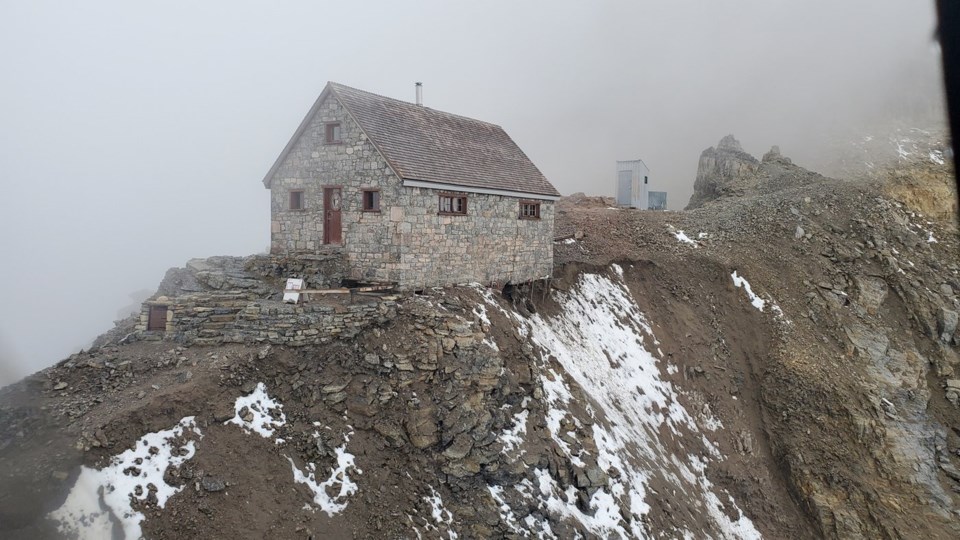The Abbot Pass hut stood for decades in a rugged saddle between two iconic peaks, overlooking the limpid turquoise of Banff National Park's Lake Louise — a destination for alpinists from around the world until the ground melted beneath it and forced its closure.
University of Calgary researchers have now used a century's worth of entries from the hut's log to illuminate how climate change is erasing historic climbs, making others more dangerous and altering the face of Canadian mountaineering.
"There were absolutely comments about how climate change has impacted the Canadian Rockies and many hut visitors expressed sadness and concern over it," wrote Kate Hanly, a geography doctoral candidate and co-author of a paper drawing on those logs published in the journal Climatic Change.
"Climate change is contributing to changes in mountaineering conditions in the Canadian Rockies," she says in an email.
Mountain guides agree.
"Classic routes have changed," says Paul Vidalin, president of the Association of Canadian Mountain Guides with 25 years of guiding experience.
"In places the ice is gone and there's nothing but rotten rock left. What used to be nice mellow glacier (ski) runs are now really crevassed."
James Gudjonson, a vice-president of the Alpine Club of Canada, has been guiding climbers and skiers for 30 years.
"It's really disheartening," he says. "You know a lot (of routes) have gone away or are slowly going away and they're not coming back."
Hanly's paper combines 6,283 trip reports left by alpinists in the Abbot Pass hut log with those in a modern climbers database. It covers from 1923 to 2024.
Early entries describe reliable ramps of firm snow en route to renowned peaks such as Mount Lefroy and Mount Victoria.
But by 2017, all Lefroy climbers reported exposed ice and half faced bare, unstable rock. Five per cent of climbers on Victoria reported bare rock in the '50s, while more than half did between 2013 and 2022.
That rock means more than just wobbly footing. As ice that holds it in place melts, it falls.
On one route to Abbot — used since early in the last century — there were no reports of dangerous rockfall for the first 50 years of the hut's log. In the last decade, three-quarters of climbing parties mentioned it.
The findings were similar for another route to the hut.
"The typical right side was a war zone of rockfall with many near misses," said a 2009 entry.
The threats aren't limited to Abbot Pass, says Christoph Dietzfelbinger, who has guided since the '80s in British Columbia's Coast Range.
"On Mount Edziza, the access to the summit ridge used to be a simple snow slope," he says in an email. "Now it is a 30- to 70-metre-high slope of black water ice that requires full alpine ice gear."
In the Bugaboos range south of Golden, B.C., a popular col in what may be Canada's most famous climbing area is becoming increasingly inaccessible as it loses snow.
"I think it will eventually become a place where you just don't go," says Gudjonson. "It was the access point for dozens of routes."
Other hazards are also increasing.
Lower snowpacks and increased melting changes the shape and angle of glaciers, making them more prone to avalanches. Snow bridges allowing alpinists to safely cross crevasses are weakened.
Gudjonson has seen that effect on the Wapta Icefield, a popular high-altitude glacier ski touring destination between Banff and Jasper, Alta.
"You just don't have that snow because there's so much rain and warm temperatures," he says. "You're not getting that good bridging.
"It's OK in the summer — you can see the ice. But the real issue is the thinner snowpack in the winter."
As well, areas that usually see deep, stable snowpacks now experience big dumps followed by long droughts, sometimes punctuated by rain or thaw. That creates snow layers and makes avalanche assessment even harder.
"It's more erratic, more extreme," says Vidalin.
"There seems to be more problem layers (in the snow), more variability, more complexity."
Climate change is reducing some hazards. For example, Hanly says the thinner snowpack has shrunk cornices that used to hang over Victoria's southeast ridge, making travel faster and easier.
New routes may open up as guides adapt.
"The only constant in guiding is change," Hanly writes in the email. "I don’t think we are at risk of losing the culture of mountaineering in this country (at least right now) but I am pretty sure it will continue to evolve."
There are economic consequences, Hanly adds.
"The warm and dry weather in January reduced ice climbing opportunities so significantly that some guides didn’t have any work. In the Canadian Rockies and especially the Bow Valley, where so much guiding occurs, climate change could have a significant impact on the industry with potentially cascading effects on the tourism and hospitality industry."
Gudjonson points to the industry that's grown up around backcountry skiing and mountaineering.
"What's going to happen to the commercial operators?" he asks.
But that's not his main concern. The 2018 closure of the Abbot Pass hut haunts climbers and hikers, he says.
"We have 100 years of history and something that's woven into the culture of the mountain community. You lose those historical places forever."
Guides talk about it all the time, says Dietzfelbinger.
"There is something best called ecological grief," he wrote. "A landscape that has been dear to me and that has nurtured many experiences is irrevocably changed."
This report by The Canadian Press was first published June 2, 2024.
Bob Weber, The Canadian Press

